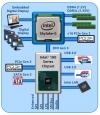The new specification could speed up calculations in supercomputers, boost in-memory computing for applications like databases, or aid in providing faster response times to web requests. HMC technology is based on current DDR3 DRAM but memory modules are structured like a cube instead of being placed flat on a motherboard. By stacking memory chips in a cube it is possible to link them through a wire-like connection called Through Silicon Via. HMC is being seen as a link technology to things like MRAM (magnetoresistive RAM), RRAM (resistive RAM) and PCM (phase-change memory), which are still years away from being useful.
HMC Gen2 specification boosts memory throughput to 30G bps (bits per second), which is double that of the previous specification. The Gen2 specification will be finalized by the middle of this year, and will replace the previous specification released in the middle of last year.
HMC is being pushed by Samsung and Micron and members of the consortium include Microsoft, ARM, Altera and Xilinx. Micron has released HMC products with multiple memory channels with throughput speed of 160GBps (bytes per second). With the new specification, throughput of that memory product could double, Black said.




